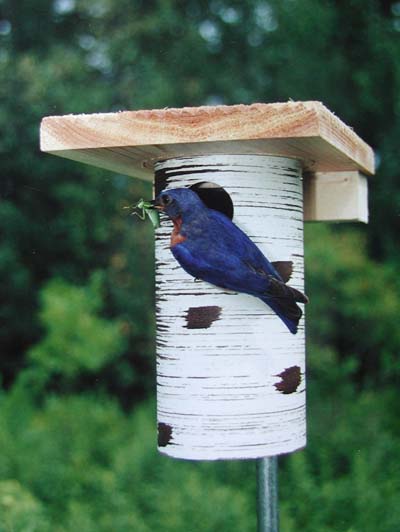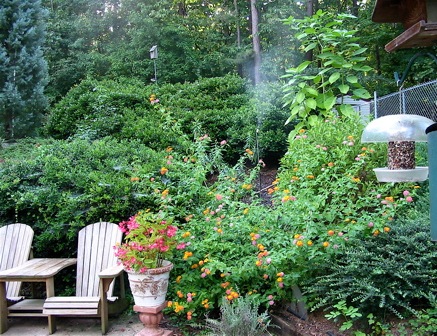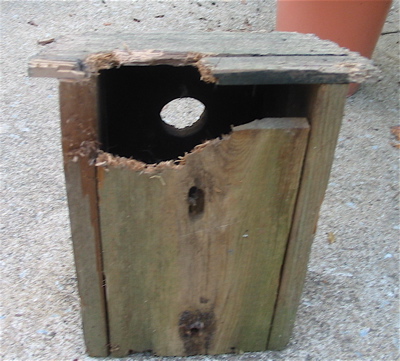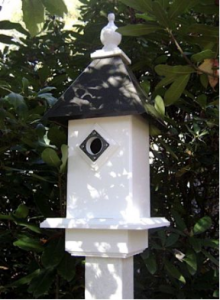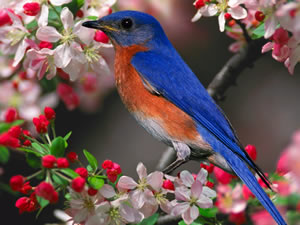-
Really Popoular Bluebird Houses~The Gilbertson
Dubbed “the Gilbertson Nest Box” it might just resemble a coffee can at first glimpse. The shape is definitely similar, although the birch appearance is much more aesthetic. Actually, there’s a lot more to these bluebird houses than meets the eye!
Not only North American Bluebird Society (NABBS) Approved, these unique style houses are bluebird-approved too… big time! The birch-like log is PVC, so it outlasts most wooden boxes. Painted darker on the inside, it must resemble a natural nest cavity for bluebirds? The overhang roof helps thwart some predators, and the elements. A good 6-inch depth from entrance to floor helps protect nestlings from bully bird attacks. And, they’ve got to be some of the easiest birdhouses to install too. Half-inch conduit fits right in the hole on the back portion of the roof. Placing 8-10 inches in the ground keeps these light-weight bluebird houses sturdy.
A baffle is suggested to further protect nestlings from ground predators, and one can be made fairly easily and inexpensively too. We did one from 4-inch diameter PVC pipe. An end cap is needed, along with a radiator or hose clamp on the pole to secure the baffle. Some hunter green spray paint makes it not only effective, but good looking as well.
The same kind of baffle may be constructed using stove pipe, and likely for even less cost. The important thing is that it wobbles (making it harder for critters to climb) and the length should be at least three feet.
Ok, back to the bluebird house: If you’re one who monitors the progress from egg-laying through hatching, and fledging, the Gilbertson is a tad different. After the first few times you get the hang of it and it’s actually fun to be able to look down and see everyone in full view. (But don’t do this too close to fledge time, you could cause a premature take-off). A simple squeeze between thumb and forefinger with both hands (right below the roof) elongates the PVC, and the house pops right off the two screw heads that securely hold it in place. Sounds weird? Maybe… but it’s pretty ingenious!
Of all the bluebird houses around our property, the Gilbertson, for some reason is the first to see nest building
activity each spring. This past season, it hosted three successful broods and 16 fledgelings! Pretty good for one little coffee-can looking nest box! So these bluebird houses are not only NABBS Approved… they’re definitely bluebird approved too!
P.S. Fall is the perfect time to install birdhouses! Even though it will be months before anyone begins to nest, places for roosting are equally important for resident birds. We do see some snow and frigid winters here in North Georgia, but bluebirds still stick around if the habitat is suitable. We find that heated baths, daily mealworms, and roosting spots keep them fat and happy around our place 🙂
-
Don’t let this happen to your blue bird houses
Just ironic that this old blue bird house had a predator guard on the entrance! Of no use to any bird now, it’s downright dangerous for any nestlings. Wide open to predators, though I’ve probably discarded a fine squirrel home 🙁 Because it was attached to a tree, surrounded by brush and limbs, it wasn’t exactly bluebird real estate. Someone had nested in there, the thick moss nest was likely built by a Titmouse, Nuthatch or Carolina Wren.
Now is the time to check blue bird houses (and all nest boxes) for repairs and nest removal. They’ll still be a welcomed environment during the off-season! As swell roosting spots for lots of feathered friends… through fall and winter. Adding shavings to your houses helps to insulate them, but always opt for pine, as cedar shavings can cause irritation.
Be sure to discard any nests in the trash, as predators will be attracted to them. Grabbing them with a plastic bag (from the grocery store) is pretty quick & easy. It’s a good idea to clean and disinfect blue bird houses to rid them of mites or other pests. A solution of bleach and water does the trick well, at a ratio of 1:10. Scrub with a hard-bristle brush, rinse well, and let air-dry.
As far as the rotted house pictured? It was headed for the trash, but second thoughts say leave it for the squirrels!
-
These Vinyl bluebird houses are NABS Approved
It’s so time to get ready, like yesterday… they’re scouting and building nests already in most parts of the country. Yes, Bluebird season 2012 is here!
If you haven’t done so already, check for old nests in bluebird houses (and other nest boxes too). Best to wear gloves for this chore, and dispose of the nest away from the birdhouse as old nests will attract predators. Clean the box with a mild bleach/water solution (1:10). Scrub, rinse well with water, and let dry in the sun.
The NABS reference above? It stands for the North American Bluebird Society, who gives their approval on certain bluebird houses. The houses must meet specific criteria that’s beneficial to hosting successful bluebird broods and fledges. This is elementary stuff for serious blue-birders, but so many of us are novices and we all have to start somewhere! If you’ve been unsuccessful in enticing bluebirds to your yard, there are lots of great suggestions, and some fantastic information at www.sialis.org. We would strongly recommend this well organized and informative site for anyone interested in hosting blu
ebirds.
Bluebird houses will differ for the Eastern and Mountain/Western Bluebird, although Eastern Bluebirds may use a Mountain Bluebird House. Eastern Blues require a 1-1/2 inch diameter hole, where as Mountain/Western Blues require a 1-9/16 inch entrance. This is where some of NABS Approval comes into play because an entrance that is 1-5/8 inch, will allow Starlings to enter the box, but Starlings can not enter through a 1-9/16 inch hole. Now who would know that? Floor size (4×4 for Eastern Blues, and 5×5 for Western/Mountain Blues) and ventilation are some other criteria for approval by NABS. A predator guard at the entrance of your bluebird house always helps to ensure successful fledges, as does a baffle if the house is pole or post-mounted.
Water, food, and potential nesting spots are key to enticing these fantastic birds! Bluebirds prefer open area for their hunting style (swooping to catch insets), so if your yard is heavily wooded, chance are Bluebirds won’t find it suitable… but other birds will. Chickadees and Nuthatches are already scouting nest boxes and building nests too. We just tried put up one of those side-entry houses supposedly meant for Nuthatches… we’ll see how that goes soon enough.
Spring has sprung early this year, so get in the yard and help local birds thrive!

